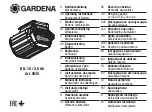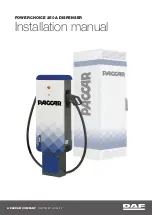
31
8. CONNECTION / START-UP / ChARGING
Before plugging in the mains plug, ensure that the voltage indicated on the charger is compatible
with the mains voltage available. Do not connect the device if the data doesn’t match the available
mains voltage. An incorrect supply voltage will entail serious damage.
Be careful when handling the mains cables and mains connectors. Mains voltage may cause fatal
electric shocks.
The mains socket to which the charger is connected must be easily accessible, so the device can
be quickly isolated from the mains voltage in the event of a fault.
Do not leave the cables trailing free; route them in an orderly and professional way to prevent
accidents.
The battery can remain connected to the vehicle electronics during charging except when charg-
ing in charging programmes mode 2 and 5. when charging in mode 2 and 5, the battery must
always be disconnected from the vehicle electronics. If not observed, there is the risk of the
vehicle electronics being damaged due to overvoltage.
• Connect the red terminal clamp to the positive pole and the black clamp to the battery pole.
• Place the thermal sensor (additional black cable with small plastic housing at the end) on the battery. This sensor
monitors the battery and ambient temperature.
• Connect the mains plug to a mains socket. The POWER LED (1) indicator is lit. The device is in standby mode.
The charger saves the charging programme last used except for charging programmes mode 2, 5 and 7.
Therefore, you also could connect the charger to the battery first and then plug the mains plug into the mains
socket. In this case, the charging process starts with the last charging programme. The corresponding LED
lights up.
• Select the appropriate charging programme (mode 1 to 8) at the charger using the MODE button (2). To do this,
press the MODE (2) button repeatedly until the operating mode is displayed.
Depending on the recognised battery voltage, not all charging programmes are available.
• When the battery is connected with the correct polarity, not defective (high-ohmic/disconnected) and connected to
the mains supply, it starts to charge.
• The LED for the selected charging programme is illuminated during charging and CHARGING (11) is shown in the
display (15).
• Press the DISPLAY button (14) to show the charging voltage vOLTAGE (13) or the charging current CURRENT (12).
• When the display (15) shows CHARGING (11) 100 (%) as charging status, the charging process is complete and
the charger switches to conservation charging. Remove the battery from the charger and then pull the mains plug
out of the mains socket.
Note regarding the charging process
• Charging processes vary in length. The charging process of a large battery with a capacity of e.g., 230 Ah, may
in fact take very long depending on the condition of the battery (battery is old or new; battery is flat or deeply
discharged, etc.).
















































